Q&A: The Higgs boson
- Published
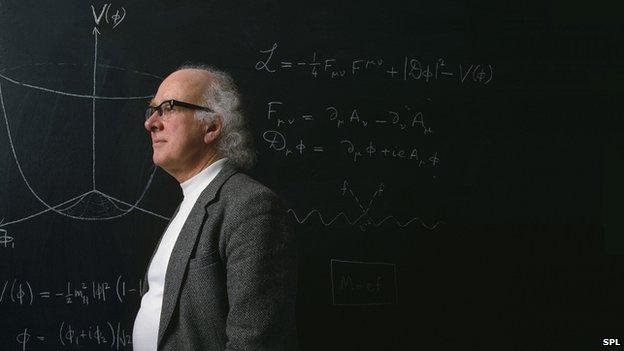
Six theoreticians, including the English physicist Peter Higgs, first proposed the Higgs mechanism in 1964
Scientists at the <link> <caption>Large Hadron Collider (LHC)</caption> <url href="http://www.bbc.co.uk/science/space/universe/exploration/large_hadron_collider" platform="highweb"/> </link> have discovered a new sub-atomic particle consistent with the long-sought Higgs boson.
The particle's confirmation would stand out as one of the great scientific achievements of the 21st Century so far.
But what exactly is the Higgs boson, and why have particle physicists spent more than 40 years searching for it?
What is the Higgs boson?
The Higgs so far definitively exists only in the minds of theoretical physicists. There is a sturdy theory for how much of the Universe works - all of the particles that make up atoms and molecules and all the matter we see, most of the forces that direct them, and a small zoo of more exotic particles. This is called the Standard Model. However, there is a glaring hole in the theory: it does not explain how it is that some of those particles gain their mass. The Higgs mechanism was proposed in 1964 by six physicists, including the Edinburgh-based theoretician <link> <caption>Peter Higgs</caption> <url href="http://www.bbc.co.uk/news/science-environment-16222710" platform="highweb"/> </link> , as an explanation to fill this hole.
Best explanation of Higgs boson?

Scientists' best theory for why different things have mass is the "Higgs field" - where mass can be seen as a measure of the resistance to movement. The "Higgs field" is shown here as a room of physicists chatting among themselves.

A well-known scientist walks into the room and causes a bit of a stir - attracting admirers with each step and interacting strongly with them - signing autographs and stopping to chat.

As she becomes surrounded by admiring fans, she finds it harder to move across the room - in this analogy, she acquires mass due to the "field" of fans, with each fan acting like a single Higgs boson.

If a less popular scientist enters the room, only a small crowd gathers, with no-one clamouring for attention. He finds it easier to move across the room - by analogy, his interaction with the bosons is lower, and so he has a lower mass.
What is so important about mass?
Professor Jim Al-Khalili explains what the Higgs boson is and why its discovery is so important
Mass is, quite simply, a measure of how much stuff an object - a particle, a molecule, or a Yorkshire terrier - contains. If not for mass, all of the fundamental particles that make up atoms and terriers would whiz around at light speed, and the Universe as we know it could not have clumped up into matter. The <link> <caption>Higgs mechanism</caption> <url href="http://www.bbc.co.uk/programmes/p004y2b7" platform="highweb"/> </link> proposes that there is a field permeating the Universe - the Higgs field - that allows particles to obtain their mass. Interactions with the field - with the Higgs bosons that come from it - are purported to give particles mass. This is not unlike a field of snow, in which trudging through impedes progress; your shoes interacting with snow particles slows you down.
How do scientists search for the Higgs boson?
Ironically, the Standard Model does not predict an exact mass for the Higgs itself. Particle accelerators such as the LHC are used to systematically search for the particle over a range of masses where it could plausibly be. The LHC works by smashing together two beams of the sub-atomic particles called protons at close to light-speed. This generates a vast shower of particles that are only created at high energies. The Higgs will probably never be observed directly, but scientists at the LHC have been looking for a Higgs that fleetingly exists in this soup of particles. If it behaves as researchers think it will, it should decay further into yet more particles, leaving a trail that proves its existence.
Prof John Womersley: We know something about the universe that we didn't yesterday"
It is not the first machine to hunt for the particle. The LEP machine, which ran at <link> <caption>Cern</caption> <url href="http://public.web.cern.ch/public/" platform="highweb"/> </link> from 1989-2000, ruled out the Higgs up to a certain mass, and until it was switched off in 2011, the <link> <caption>US Tevatron accelerator</caption> <url href="http://www-bdnew.fnal.gov/tevatron/" platform="highweb"/> </link> searched for the particle above this range. On Monday, the Tevatron team released their final analysis, which tantalisingly points to a particle much like the one that the LHC data suggests.
LHCb
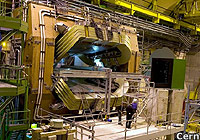
The Large Hadron Collider Beauty (LHCb) detector is designed to answer a specific question: where did all the anti-matter go?
Equal amounts of matter and its counterpart anti-matter were created in the Big Bang. But today we find no evidence of, for example, anti-matter galaxies or stars. The LHCb seeks to solve this mystery by studying a type of particle called the "beauty quark".
ATLAS
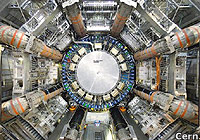
One of the general purpose detectors which has found evidence of a new particle matching the elusive Higgs boson.
Atlas has an enormous doughnut-shaped magnet system, consisting of eight 25m-long (82ft) superconducting magnet coils arranged into a cylinder, which can collide protons that have been accelerated to fantastic energies.
Atlas is also looking for extra dimensions of space, microscopic black holes, and evidence for dark matter.
ALICE
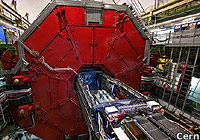
While the other large Hadron Collider detectors use proton beams to do their science, ALICE (A Large Ion Collider Experiment) relies on smashing together electrically charged lead atoms.
Scientists are aiming to recreate a "liquid" state of matter called quark-gluon plasma, which existed just after the Big Bang when the early Universe was still extremely hot. They are then studying the cooling plasma in the hope of discovering how particles are born.
CMS
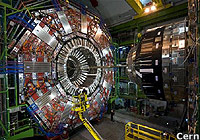
The Compact Muon Solenoid (CMS) is a general purpose detector with which scientists believe they have found evidence of a new particle consistent with the Higgs boson.
The detector is built around a huge solenoid magnet - a cylindrical coil of superconducting cable which generates a magnetic field about 100,000 times as strong as the Earth's.
When will we know if we have found it?
Particle physicists are a notoriously conservative bunch when it comes to saying they have found something. If you flip a coin 10 times and get eight heads, you might think the coin is somehow "loaded". But only after hundreds of flips can you say so with the kind of certainty that physics requires for a formal "discovery".
The first hurdle is to definitively nail down the particle's mass - showing up as a kind of "bump" in the data - and that part looks to be just around the corner. What is next is to make sure that it behaves as the theory predicts it should - how it interacts with other particles and in turn decays in to yet more particles. This is very much the frontier of high-energy physics and a complete and certain entry into the Standard Model is probably a long way off yet.
And what then?
Most professional physicists would say that finding the Higgs in precisely the form that theory predicts would <link> <caption>actually be a disappointment</caption> <url href="http://press.web.cern.ch/press/background/B10-Higgs_evolution_or_revolution_en.html" platform="highweb"/> </link> . Large-scale projects such as the LHC are built with the aim of expanding knowledge, and confirming the existence of the Higgs right where we expect it, while it would be a triumph for our understanding of physics, would be far less exciting than not finding it. It is those kinds of surprises that have led to great revolutions in science.
Rest easy, though - if the trend continues and this simplest version of the Higgs takes pride of place in the Standard Model, many big questions remain. After all, the Standard Model explains matter as we know it, but there is much reason to believe that matter only makes up 4% of the observable Universe. The rest - dark matter and dark energy - may prove even harder to pin down. It is as if we are near to completing one side of a Rubik's cube and being reminded the other five are all a jumble.
- Published4 July 2012
- Published2 July 2012
